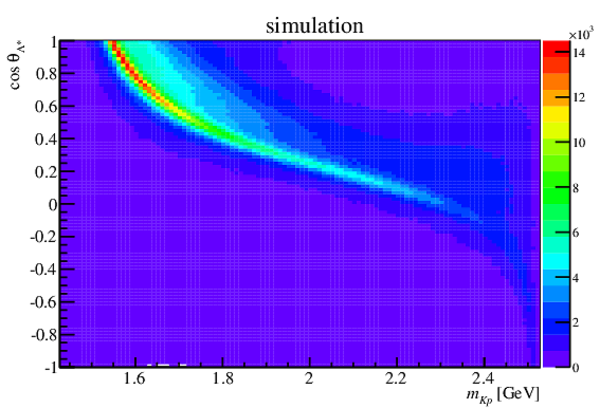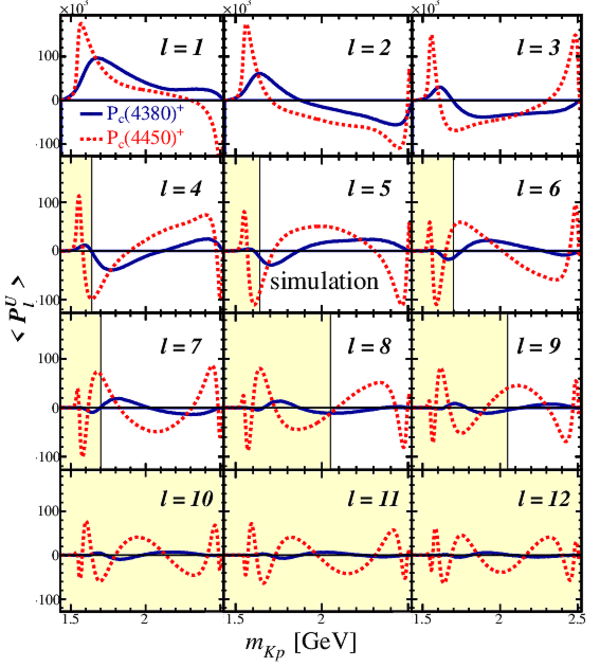Model-independent evidence for $J/\psi p$ contributions to $\Lambda_b^0\to J/\psi p K^-$ decays
[to restricted-access page]Information
LHCb-PAPER-2016-009
CERN-EP-2016-086
arXiv:1604.05708 [PDF]
(Submitted on 19 Apr 2016)
Phys. Rev. Lett. 117 (2016) 082002
Inspire 1449086
Tools
Abstract
The data sample of $\Lambda_b^0\to J/\psi p K^-$ decays acquired with the LHCb detector from 7 and 8 TeV $pp$ collisions, corresponding to an integrated luminosity of 3 fb$^{-1}$, is inspected for the presence of $J/\psi p$ or $J/\psi K^-$ contributions with minimal assumptions about $K^- p$ contributions. It is demonstrated at more than 9 standard deviations that $\Lambda_b^0\to J/\psi p K^-$ decays cannot be described with $K^- p$ contributions alone, and that $J/\psi p$ contributions play a dominant role in this incompatibility. These model-independent results support the previously obtained model-dependent evidence for $P_c^+\to J/\psi p$ charmonium-pentaquark states in the same data sample.
Figures and captions
|
Excitations of the $\Lambda $ baryon. States predicted in Ref. [7] are shown as short horizontal bars (black) and experimentally well-established $\Lambda ^*$ states are shown as green boxes covering the mass ranges from $M_0-\Gamma_0$ to $M_0+\Gamma_0$. The $m_{Kp}$ mass range probed in $\Lambda ^0_ b \rightarrow { J \mskip -3mu/\mskip -2mu\psi \mskip 2mu} p K ^- $ decays is shown by long horizontal lines (blue). The $l_{\rm max}(m_{Kp})$ filter is shown as a stepped line (red). All contributions from $\Lambda ^*$ states with $J^P$ values to the left of the red line are accepted by the filter. The filter works well also for the excitations of the $\Sigma $ baryon [11,7] (not shown). |
lmax_new.pdf [14 KiB] HiDef png [140 KiB] Thumbnail [125 KiB] *.C file |

|
|
Efficiency-corrected and background-subtracted $m_{Kp}$ distribution of the data (black points with error bars), with $\cal F(m_{Kp}|H_0)$ superimposed (solid blue line). $\cal F(m_{Kp}|H_0)$ fits the data by construction. |
Data_mkp.pdf [25 KiB] HiDef png [127 KiB] Thumbnail [100 KiB] *.C file |
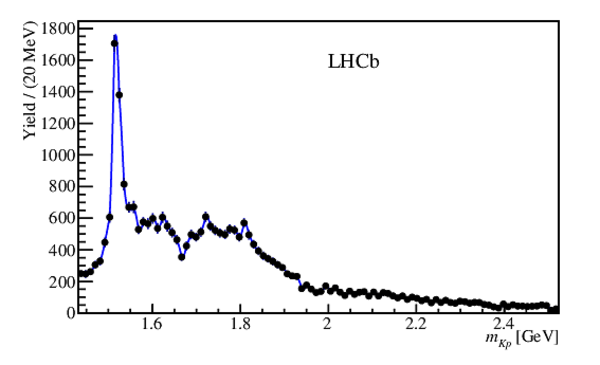
|
|
Legendre moments of $\cos\theta_{\Lambda ^*}$ as a function of $m_{Kp}$ in the data. Regions excluded by the $l\lel_{\rm max}(m_{Kp})$ filter are shaded. |
UMom_A[..].pdf [40 KiB] HiDef png [459 KiB] Thumbnail [359 KiB] *.C file |

|
|
Efficiency-corrected and background-subtracted $m_{ { J \mskip -3mu/\mskip -2mu\psi \mskip 2mu} p}$ distribution of the data (black points with error bars), with $\cal F(m_{ { J \mskip -3mu/\mskip -2mu\psi \mskip 2mu} p}|H_0)$ (solid blue line) and $\cal F(m_{ { J \mskip -3mu/\mskip -2mu\psi \mskip 2mu} p}|H_1)$ (dashed black line) superimposed. |
Data_m[..].pdf [31 KiB] HiDef png [153 KiB] Thumbnail [106 KiB] *.C file |
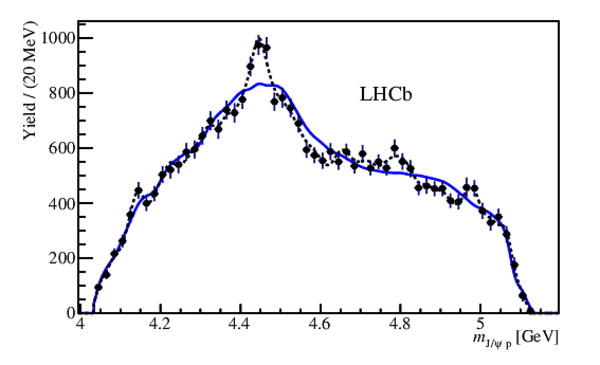
|
|
Distributions of $\Delta( -2\ln L )$ in the model-independent pseudoexperiments corresponding to $H_0$ (red falling hatched) compared to the distributions for pseudoexperiments generated from various amplitude models and, in the inset, to the bifurcated Gaussian fit function (solid line) and the value obtained for the data (vertical bar). |
dll.pdf [24 KiB] HiDef png [557 KiB] Thumbnail [337 KiB] *.C file |
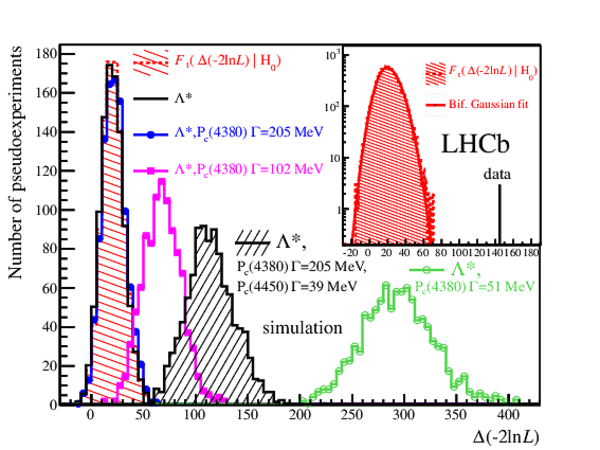
|
|
Efficiency-corrected and background-subtracted $m_{ { J \mskip -3mu/\mskip -2mu\psi \mskip 2mu} K}$ distribution of the data (black points with error bars), with $\cal F(m_{ { J \mskip -3mu/\mskip -2mu\psi \mskip 2mu} K}|H_0)$ (solid blue line) and $\cal F(m_{ { J \mskip -3mu/\mskip -2mu\psi \mskip 2mu} K}|H_1)$ (dashed black line) superimposed. |
Data_m[..].pdf [73 KiB] HiDef png [151 KiB] Thumbnail [105 KiB] *.C file |
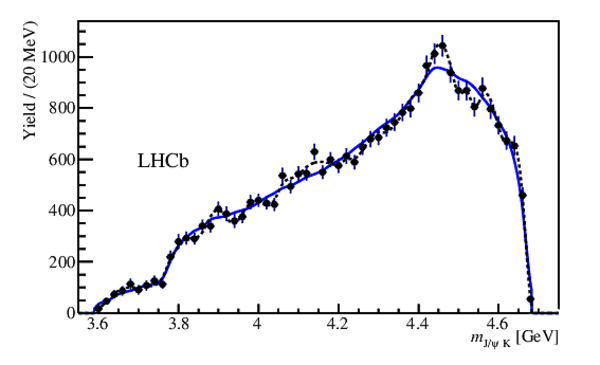
|
|
Distribution of $m_{ { J \mskip -3mu/\mskip -2mu\psi \mskip 2mu} p K}$ in the data with the fit of signal and background components superimposed [3]. The fit is used to determine the background fraction $\beta$ in the $\pm2\sigma$ signal region around the $\Lambda ^0_ b $ peak (shown by the vertical red bars). The sidebands used in the background subtraction are also shown. |
mjpsipk.pdf [28 KiB] HiDef png [179 KiB] Thumbnail [137 KiB] *.C file |
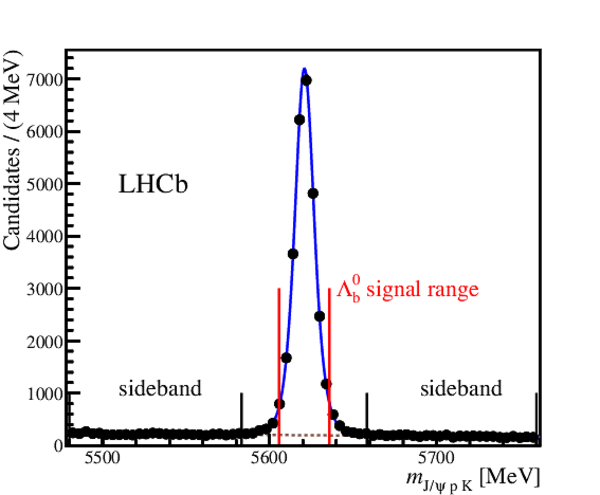
|
|
Background-subtracted and efficiency-corrected distribution of the cosine of the $\Lambda ^*$ helicity angle versus $m_{Kp}$ for the data. |
Data_K[..].pdf [46 KiB] HiDef png [904 KiB] Thumbnail [679 KiB] *.C file |

|
|
Distribution in a pseudoexperiment of the cosine of the $\Lambda ^*$ helicity angle versus $m_{Kp}$ for the amplitude model with $\Lambda ^*$ resonances only. |
Lz_KpR[..].pdf [52 KiB] HiDef png [714 KiB] Thumbnail [555 KiB] *.C file |

|
|
Distribution in a pseudoexperiment of the cosine of the $\Lambda ^*$ helicity angle versus $m_{Kp}$ for the amplitude model with the $P_c(4380)^+$ and $P_c(4450)^+$ resonances only. |
TwoPc_[..].pdf [51 KiB] HiDef png [675 KiB] Thumbnail [541 KiB] *.C file |
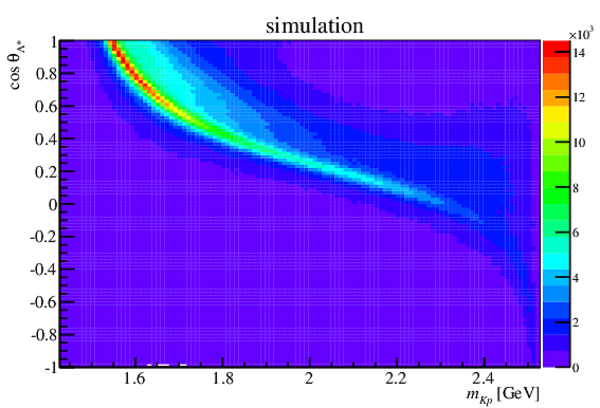
|
|
Legendre moments of $\cos\theta_{\Lambda ^*}$ as a function of $m_{Kp}$ for the simulated data from the amplitude models with only $\Lambda ^*$ (solid blue lines) and with only $P_c(4380)^+$, $P_c(4450)^+$ contributions (dashed red lines), scaled by $0.5$. The regions excluded by the $l\lel_{\rm max}(m_{Kp})$ filter are shaded. |
UMom_C[..].pdf [96 KiB] HiDef png [570 KiB] Thumbnail [402 KiB] *.C file |
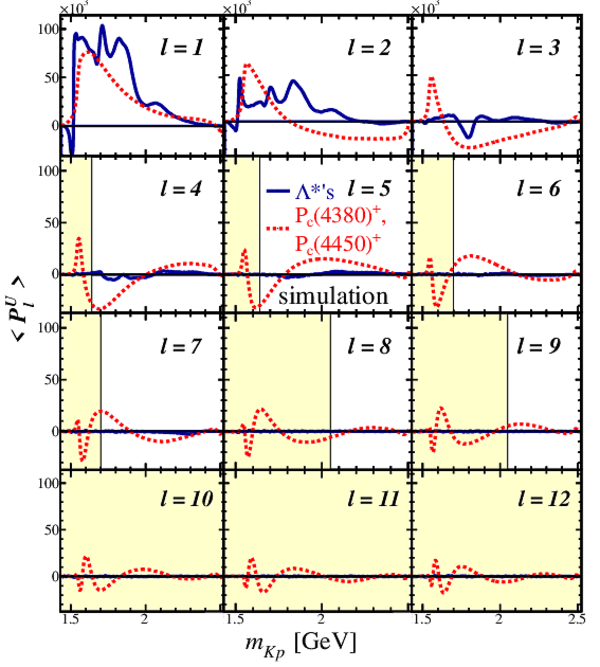
|
|
Legendre moments of $\cos\theta_{\Lambda ^*}$ as a function of $m_{Kp}$ for the simulated data from amplitude models with only $P_c(4380)^+$ (solid blue lines) and only $P_c(4450)^+$ contributions (dashed red line). |
UMom_IndPc.pdf [59 KiB] HiDef png [673 KiB] Thumbnail [469 KiB] *.C file |

|
|
Animated gif made out of all figures. |
PAPER-2016-009.gif Thumbnail |

|
Supplementary Material [file]
Created on 26 April 2024.

